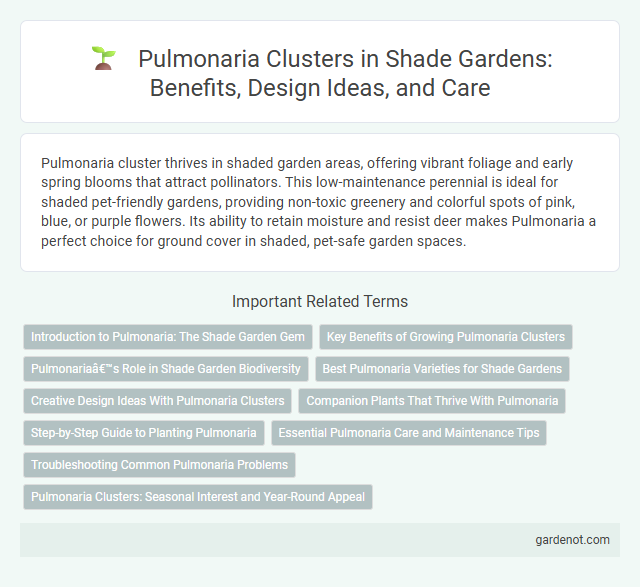Pulmonaria cluster thrives in shaded garden areas, offering vibrant foliage and early spring blooms that attract pollinators. This low-maintenance perennial is ideal for shaded pet-friendly gardens, providing non-toxic greenery and colorful spots of pink, blue, or purple flowers. Its ability to retain moisture and resist deer makes Pulmonaria a perfect choice for ground cover in shaded, pet-safe garden spaces.
Introduction to Pulmonaria: The Shade Garden Gem
Pulmonaria, commonly known as lungwort, is a shade-loving perennial prized for its early spring blooms and attractive spotted foliage. This cluster thrives in moist, well-drained soils and offers vibrant flowers ranging from pink to blue, attracting pollinators like bees. Pulmonaria's tolerance for shady gardens makes it an essential plant for adding color and texture under trees and in woodland borders.
Key Benefits of Growing Pulmonaria Clusters
Pulmonaria clusters thrive in shade gardens, offering vibrant early spring blooms that attract pollinators such as bees and butterflies, enhancing biodiversity. Their evergreen, spotted foliage provides lasting visual interest and excellent ground cover, suppressing weeds and conserving soil moisture. Pulmonaria's tolerance to damp, shaded environments reduces maintenance needs, making them ideal for low-light garden areas.
Pulmonaria’s Role in Shade Garden Biodiversity
Pulmonaria cluster significantly enhances shade garden biodiversity by providing early spring nectar sources essential for pollinators such as bees and butterflies. Its dense, variegated foliage creates microhabitats that support diverse soil microorganisms and small invertebrates, contributing to ecosystem health. The plant's adaptability to low-light conditions ensures continuous ground cover, reducing soil erosion and promoting a balanced understory environment.
Best Pulmonaria Varieties for Shade Gardens
Pulmonaria varieties such as 'Blue Ensign,' 'Raspberry Splash,' and 'Majeste' thrive in shade gardens, offering vibrant foliage and early spring blooms. 'Blue Ensign' features striking silver-spotted leaves with deep blue flowers, while 'Raspberry Splash' presents a unique combination of dark green leaves with pink blossoms. These Pulmonaria cultivars excel in moist, well-drained soil and partial to full shade, making them ideal for enhancing low-light garden areas.
Creative Design Ideas With Pulmonaria Clusters
Pulmonaria clusters bring vibrant texture and color to shade gardens with their spotted leaves and early spring blooms in shades of blue, pink, and white. Pairing Pulmonaria with hostas and ferns creates layered foliage contrasts that enhance visual depth and interest in low-light areas. Using Pulmonaria clusters as groundcover beneath taller shade trees helps to fill gaps while adding seasonal brightness and attracting early pollinators.
Companion Plants That Thrive With Pulmonaria
Pulmonaria clusters thrive in shade gardens alongside companion plants like hostas, ferns, and astilbes, which share similar moisture and light requirements. These perennials complement Pulmonaria's early spring blooms with their lush foliage and late-season flowers, enhancing garden texture and color throughout the growing season. Planting Pulmonaria with shade-tolerant groundcovers such as Heuchera or Hakonechloa also helps maintain soil moisture and prevent weed growth, creating a healthy, vibrant garden ecosystem.
Step-by-Step Guide to Planting Pulmonaria
Choose a shaded, well-drained location with rich, moist soil to plant Pulmonaria clusters. Dig holes twice the size of the root ball and space each plant 12-18 inches apart for optimal growth. Water thoroughly after planting and mulch around the base to retain moisture and regulate soil temperature.
Essential Pulmonaria Care and Maintenance Tips
Pulmonaria clusters thrive in moist, well-drained soil enriched with organic matter, making them ideal for shaded garden beds. Regular watering ensures soil remains consistently damp, while mulch helps retain moisture and suppress weeds. Pruning spent flowers promotes new growth and maintains a tidy appearance, enhancing the plant's vibrant foliage throughout the growing season.
Troubleshooting Common Pulmonaria Problems
Pulmonaria clusters often face common issues such as leaf spotting caused by fungal infections like powdery mildew or rust. To troubleshoot, ensure proper air circulation by spacing plants adequately and remove affected leaves promptly to prevent spread. Regular watering at the base and avoiding overhead irrigation reduces moisture on foliage, minimizing disease risks in shaded garden environments.
Pulmonaria Clusters: Seasonal Interest and Year-Round Appeal
Pulmonaria clusters offer vibrant seasonal interest with their early spring blooms featuring striking blue, pink, and white flowers that attract pollinators. Their evergreen or semi-evergreen foliage provides year-round texture and visual appeal in shade gardens, especially with distinctive spotted leaves that brighten dark corners. These low-maintenance perennials thrive in moist, well-drained soils and tolerate deep shade, making them ideal for woodland gardens and shaded borders.
Pulmonaria cluster Infographic

 gardenot.com
gardenot.com